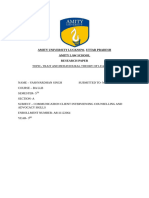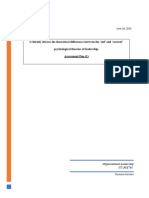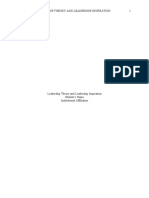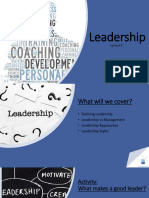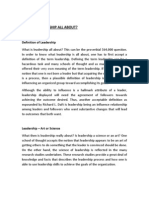Fundamentals 20 Knowledge 20 of 20 Leadership
Fundamentals 20 Knowledge 20 of 20 Leadership
Uploaded by
Amrit PatnaikCopyright:
Available Formats
Fundamentals 20 Knowledge 20 of 20 Leadership
Fundamentals 20 Knowledge 20 of 20 Leadership
Uploaded by
Amrit PatnaikOriginal Description:
Copyright
Available Formats
Share this document
Did you find this document useful?
Is this content inappropriate?
Copyright:
Available Formats
Fundamentals 20 Knowledge 20 of 20 Leadership
Fundamentals 20 Knowledge 20 of 20 Leadership
Uploaded by
Amrit PatnaikCopyright:
Available Formats
See discussions, stats, and author profiles for this publication at: https://www.researchgate.
net/publication/6937144
What Is Leadership?
Article in Journal of Veterinary Medical Education · February 2006
DOI: 10.3138/jvme.33.2.280 · Source: PubMed
CITATIONS READS
5 8,596
3 authors, including:
Donald J Klingborg Dale Moore
University of California, Davis Washington State University
29 PUBLICATIONS 410 CITATIONS 93 PUBLICATIONS 1,675 CITATIONS
SEE PROFILE SEE PROFILE
Some of the authors of this publication are also working on these related projects:
Veterinary Medicine Student Leadership Training View project
All content following this page was uploaded by Donald J Klingborg on 27 May 2014.
The user has requested enhancement of the downloaded file.
Leadership and Professional Development
What Is Leadership?
Donald J. Klingborg g Dale A. Moore g Sonya Varea-Hammond
ABSTRACT
The demand for more effective leadership is heard throughout the health professions. Modern concepts of leadership differ
from the traditional definition of a charismatic individual leader. Historically, leadership has been vested in positions, while
today leadership is seen as a role one moves continuously into and out of, depending on the circumstance. Leadership ideas
have evolved so that newer characteristics of leaders include being a team builder; possessing creative and strategic thinking
skills; demonstrating honesty and integrity; and having the ability to motivate others to action. This article discusses some of
the history of leadership, current thoughts on attributes of effective leaders, and the differences and similarities between
leaders and managers; identifies selected teachable leadership tools; and describes various styles and purposes of existing
leadership programs.
INTRODUCTION proportion of female physicians, have more identified
Like love, leadership is universally desired but difficult to female leaders.11
define explicitly. The concept of ‘‘leadership,’’ as used today,
made its way into the general literature across the last
century and has only recently become of increasing interest LEADERSHIP HISTORY
for the health sciences. The idea of a charismatic individual From the late 1800s to about 1930, leadership theories
leader, capable of recruiting followers to his or her path, emphasized control and centralization of power. The ‘‘Great
has given way to team-based problem solving. Today, Man’’ theory, which suggests that leaders are born and
organizational goals are pursued by people who move not made, supported the existence of some mysterious
rapidly between leading and following roles. This team qualities vested in select individuals and frequently passed
model accomplishes two critical goals: better decisions are between generations. This model faded from popularity
made because leaders are listening to and considering in the 1930s and 1940s as ‘‘trait’’ theories appeared that
the diversity of input from co-workers with different attempted to identify specific traits qualifying an individual
experiences and insights, and there is improved acceptance for leadership. Stogdill identified six trait groupings
of the group decision through consensus building as a associated with leadership, including capacity, achievement,
result of the collaborative process, thereby fostering responsibility, participation, status, and situation, but
compliance.1–3 Effective leadership requires insight and concluded that these traits did not sufficiently explain
self-awareness, organization, ongoing communication and leadership: ‘‘A person does not become a leader by virtue
reinforcement, the ability to catalyze a shared future vision, of the possession of some combination of traits.’’5
and successful recruitment of followers motivated to
action.4 Effective leaders do not possess a defined thematic The late 1940s brought more psychoanalytical theories
list of personal traits5,6 but, rather, deliver both high that explored why individuals are motivated to lead,
performance in addressing organizational task issues and or to follow a particular leader, with an increased focus on
consideration for individuals with concern for interpersonal the role of groups and organizations. Investigators in
relations.7,8 the 1960s emphasized how people are influenced toward
shared goals. ‘‘Exchange theories’’ looked at understanding
Demands for more leadership, and more effective leader- the social exchanges between individuals and the
ship, are frequently heard at all levels in the health group, including rewards, status, and esteem. Situational
professions today, including in medicine, nursing, public leadership theory12,13 proposed that the social situation
health, and veterinary medicine.9,10 While references to and subordinates’ characteristics influence the leader
leadership in veterinary medicine are sparse and reflect a characteristics necessary to be successful. House14 identified
range of concepts and purposes, the number of books, four important behaviors attributed to the leader—directive
articles, and courses focused on leadership has exploded (task-oriented), achievement-oriented, supportive, and
over the last two decades. participative—and two situational variables: the subordi-
Leadership in the health sciences has a major gender bias: nate’s personal characteristics and any environmental
demands, such as the organization’s rules and procedures.
men have a higher probability of attaining leadership
positions, and women are underrepresented in higher In the 1970s there was a shift away from social psychology
medical administrative positions despite their growing and toward organizational behavior and management
workforce parity and projected future majority. Physicians science. Leadership and management roles became generally
in public health, and in those specialties with a higher confused and integrated, and ‘‘attribution theories’’ emerged
280 JVME 33(2) ß 2006 AAVMC
to look at how followers attribute certain qualities to leaders. there is an element of confusion in the literature about
‘‘Transformation’’ became a term describing leadership, where one starts and the other ends. A detailed outline of
and ‘‘transactional’’ was associated with management.15 leadership and management characteristics is provided
in Table 1. The table demonstrates differences in the
Since the 1980s, the leadership literature has become
scale, often summarized as ‘‘what should be done’’ versus
overwhelming in size and scope, often recycling concepts
‘‘how to do it,’’ and also clarifies that leadership and
such as the ‘‘Great Man’’ and ‘‘social’’ and ‘‘organizational
management attributes are overlapping, interdependent,
behavior’’ thinking, but with a twist toward ‘‘influence,’’
and both necessary for effective leadership.
‘‘transformational,’’ ‘‘servant,’’ and ‘‘collaborative’’
structures. Leaders have become more responsible to
their followers, with a more spiritual or value- or
principle-based relationship between leaders and followers. STYLES OF LEADERSHIP PROGRAMS
‘‘Vision’’ was introduced as a new leadership characteristic, Leadership programs are extremely popular today,
and ‘‘managing the dream’’ or ‘‘vision’’ has become the concentrating a wide range of purposes and learning
responsibility of the leader.15,16 objectives under the term ‘‘leadership.’’ Leadership
programs can be broadly lumped into three categories,
Today, functional leadership is seen not as a permanent with combinations of the three possible.
position but, rather, as a temporary service role, with
individuals moving in and out of leadership
Buying into the Organization
responsibility as situations change. An individual can play
Some programs lure their audience by recruiting those
both leadership and follower roles simultaneously, based on
interested in leadership education, then present information
circumstances, their interest, and their expertise.
designed to create support for the organization’s goals,
While there is widespread agreement that both leadership policies, and decisions. This approach assumes that
and management skills are necessary to effect change, from a common understanding, usually presented as
Table 1: Leadership vs. Management Matrix*,17
Leadership Management
Definitions The process-oriented, non-specific practices of The implementation of those task-oriented duties
challenging the process, inspiring a shared vision, that facilitate, support, and direct the timely and
enabling others to act, modeling the way, and efficient maintenance of operations
encouraging the heart10
Outcomes Determining what should be done: systematic Getting it done, and done well: Effective, efficient
change, transformation, paradigm shifts, significant completion of work product, maintenance of opera-
improvements or innovation, new and added value tions with a focus on quality of the product
to or from the organization
Characteristics A critical thinker, a risk taker, a visionary. Innovative, Efficient, detail oriented, a good delegator,
courageous, creative, forward thinking, open to organized, persistent, administrative.
change, able to learn from and overcome failure.
A team builder, a continuous learner, able to get A team builder, a continuous learner, able to get
along with people. Honest, dependable, competent, along with people. Honest, dependable, competent,
supportive, fair-minded, cooperative, respectful, supportive, fair-minded, cooperative, respectful,
motivating, values-driven, inspiring, resilient, patient, motivating, values-driven, inspiring, resilient, patient,
tenacious, credible, balanced, emotionally mature. tenacious, credible, balanced, emotionally mature.
Scope Focused on forward thinking and the long term. Organizational focus, policy development and
Strategic visioning and planning requiring insight, compliance, maintenance, support, and implementa-
complex choices and decision making, creating a tion of systems, incremental focused improvements.
new order, facilitating movement toward an end
goal.
Interaction Motivates and inspires; builds potential in others; Focus on individual performance and work
creates an environment that fosters learning, outcomes; maintains a productive work environment.
collaboration, and fluid teamwork and attracts high
performers.
Team building and effective functioning teams. Team building and effective functioning teams.
Impetus Self-directed, situational, opportunistic, Calendars, directives, scheduling, custom and
serendipitous; can be courageous in the face of culture, deadlines.
uncertain outcomes.
*Adapted by S.V. Hammond, D.J. Klingborg, and C. MacNeil from a matrix by the Leading Edge Consulting Group
<http://www.leadingedge.net>.
JVME 33(2) ß 2006 AAVMC 281
carefully selected and scripted fact-based but often incom- pursue the objectives. Creative thinking,19 including
plete descriptions of the organization’s circumstances, will going beyond emotions, facts, and critical thinking to
emerge unanimity of opinion and increased organizational including valuable ideas from others that might otherwise
support. The major goals are to raise awareness of the past, be discarded, thinking ‘‘outside of the box,’’ and providing
current, and future external and internal influences that an organizational framework that captures and reports
affect the organization, to create support for the current the key historical information, agrees on next steps, and
directions and policies, or, in some cases, to recruit effort identifies who is responsible and the time frame for them
from the audience to the organization’s activities focused on to complete their follow-up duties, is critical to fostering
change. Development of individual leadership knowledge, action and accomplishing preferred outcomes.
skills, and attributes is of secondary importance in this style
Understanding the misguided nature of living in a
of program. Those organizations especially concerned with
world of self-generating beliefs, inferred from personal
self-preservation commonly encourage ongoing relation-
experiences and observations and founded on highly
ships (e.g., alumni groups) to maintain the participant’s
selective ‘‘data’’ with cultural and personal filtering, which
association with the organization’s structure and values.
results in conclusions based on assumptions, is critical
to preventing inappropriate actions based on the Ladder of
Individual Growth
Inference (Figure 1).20
Other programs seek to expand and explore alternative
issues and concepts, exposing the audience to ideas and Similarly, enhancing dialogue over debate to seek mutual
problems that are generally peripheral to their area understanding and harmony and building trust and
of expertise, in an effort to prepare a more balanced comfort result in a cooperative atmosphere and shared
citizenry. These are focused on individual growth and community. Deliberation naturally follows from this
may include broad or narrow exposures designed to platform, with a weighing of costs, benefits, and
push, pull, and stretch the audience to see selected issues consequences leading to consensus rather than majority
in a larger context. rule or authoritative decision making.20 Consensus means
that everyone understands, supports, and is willing to
Leadership Toolbox implement a decision, even though it may not represent
A third program type delivers a variety of specific anyone’s first choice. Conflict management and
leadership tools, including empowering individuals with understanding the continuous interplay between people
knowledge, skills, and attitudes based on a greater under- that can be considered an ongoing ‘‘negotiation’’ contribute
standing of themselves and others, creative problem toward better outcomes for all parties.21
solving, and strategic planning. The toolbox delivered in
Intrapersonal and interpersonal tools are more challenging
this kind of program creates more effective independent
for the learner, and frequently for the instructor. These
thinkers capable of getting things done and fostering
include building self-awareness and the relationship
change. The primary goal is to give learners effective
between thoughts, feelings, and reactions; understanding
intrapersonal and interpersonal process tools to use in the
others’ feelings; appreciating differences; seeing conflict as
situations they encounter. The leadership attributes instilled
a gift of information that can foster greater understanding
have the potential to be an organizational nuisance as
on all sides; improved communications, including active
this audience assumes leadership roles that may not be
listening, questioning, and paraphrasing for greater
consistent with the organization’s direction or rate of
preferred change.
Both the ‘‘Individual Growth’’ and ‘‘Leadership Toolbox’’
models have the potential to profoundly affect participants,
and the ‘‘Leadership Toolbox’’ model is very suitable
for training the leaders of the future in a manner consistent
with the goals of professional schools.
Leadership Tools
Individual empowerment includes providing a knowledge
base, including explaining the need, defining leadership
attributes, and showing the audience how they apply
to them as individuals; creating opportunities for self-
exploration and evaluation; and delivering practice
experiences for assimilating and applying new tools in
safe learning situations. Leaders need to know more about
themselves, how they process information, barriers that
prevent optimization of their decision making and
interactions with others, and how to motivate themselves
and others to action.4
Rational tools are among the easiest to teach, and members
of the health professions usually possess and can quickly
enhance these assets. The needs include creating a shared
vision,18 understanding the mission, developing specific
goals and objectives, and agreeing on an action plan to Figure 1: The ladder of inference
282 JVME 33(2) ß 2006 AAVMC
understanding; group dynamics; decision making; and 9 Moore DA, Klingborg DJ. Development and evaluation
knowing when to lead and when to follow.22 of a leadership program for veterinary students. J Vet Med
Educ 28:10–15, 2003.
Participating in leadership roles is not without personal
cost, and resilience is an important tool to help leaders pick 10 MacNeil C. Personal communication.
themselves back up after being emotionally and physically
11 Kvaerner KJ, Aasland OG, Botten GS. Female
drained by their efforts. In the end, the tools developed
medical leadership: cross-sectional study. Brit Med J
should contribute to creating a vision, solving a problem,
318:91–94, 1999.
making a decision, creating understanding, and involving
the parties affected. Providing leadership education has 12 Hencley S. Situational behavioral approach to the study
similar costs, including a self-introspection and discovery of educational leadership. In Cunningham LC, Gephart WJ,
process that is personally challenging to the organizers eds. Leadership: The Science and Art Today. Itaska, IL: F.E.
and instructors, who must carefully define the learning Peacock, 1973:139–164.
objectives and curriculum for the course.
13 Hoy WK, Miskel CG. ed. Educational Administration:
Theory, Research, and Practice, 3rd ed. New York: Random
House, 1987 p273–274.
CONCLUSIONS
While language including the words ‘‘leader’’ and 14 House R. A path goal theory of leader effectiveness.
‘‘leadership’’ and the study of influence are relatively Admin Sci Q 16:321–338, 1971.
recent phenomena, the popular models of leadership 15 Burns J. Leadership. New York: Harper and Row, 1978
have been fluid throughout history. Time, place, need, p4, 141–168.
and circumstance all have significant impacts on effective
leadership styles. Today, the role of a leader or manager is 16 Bennis W. Managing the dream: leadership in the 21st
continually changing, and the tools and expertise required century. Training 27(5):44–46, 1990.
for these two roles overlap and are generally inseparable. 17 Kouzes JM, Posner BZ:. The Leadership Challenge: How to
Both leaders and managers create order, develop shared Get Extraordinary Things Done in Organizations. San
goals, catalyze activity, and empower followers. Effective Francisco: Jossey-Bass, 1987 p79.
leaders need to be both good managers and good leaders.23
Life is more complex, and the need for better decisions, 18 Manasse A. Vision and leadership: paying attention to
along with acceptance and implementation of those intention. Peabody J Educ 63:150–173, 1986.
decisions, is evident. Leadership education in veterinary 19 DeBono E. Six Thinking Hats. Boston: Little: Brown, 1985
medicine is effective, important, and worthy of the p13–15.
profession’s effort and investment.
20 Senge P, Kleiner A, Roberts C, Ross R, Smith B. The Fifth
Discipline Fieldbook: Strategies and Tools for Building a Learning
ACKNOWLEDGMENT Organization. New York: Doubleday, 1994 p242–261.
The authors thank Lisa St. Clair for her assistance in the
21 Fisher R, Ury W, Patton B. Getting to Yes, 2nd ed.
preparation of this manuscript.
New York: Penguin, 1991 p3–14.
22 Hesselbein F, Goldsmith M, Beckhard R. The Leader of
REFERENCES the Future. San Francisco: Jossey-Bass, 1996 p149–208.
1 Human Synergistics Incorporated. Cascades Survival
Situation Participant’s Booklet – sample <http://www. 23 Duttweiler P, Hord S. Dimensions of Effective Leadership.
humansynergistics.com/site/index.php?doc175143184>. Austin: TX: Southwest Educational Development
Accessed 03/30/06. Human Synergistics Inc., 2003. Laboratory, 1987 p65.
2 Pritchard WR. Future directions in veterinary medicine.
Durham, NC: Pew National Veterinary Education Program, AUTHOR INFORMATION
Duke University, 1988 p126–133.
Donald J. Klingborg, DVM, is Associate Dean for VM Extension
3 Giuliani R. Keynote address presented to American and Public Programs, School of Veterinary Medicine, University
Veterinary Medical Association Annual Meeting, Denver, of California, One Shields Avenue, Davis, CA 95616 USA.
CO, July 19, 2003. E-mail: djklingborg@ucdavis.edu. His interests are in
4 Kouzes JM, Posner BZ. The Leadership Challenge. leadership development, business management, and
San Francisco: Jossey-Bass, 2002 p23–29. continuing education.
5 Stogdill R. Personal factors associated with leadership: Dale A. Moore, DVM, PhD, is Associate Professor, Department
a survey of the literature. J Psychol 25:35–71, 1948 p64. of Population Medicine and Reproduction, School of Veterinary
Medicine, University of California, Davis, VMTRC, 18830 Rd 112,
6 Stogdill R. Handbook of Leadership: A Survey of Theory and Tulare, CA 93274 USA. Her interests are in educational research
Research. New York: Free Press, 1974 p64. and epidemiology.
7 Halpin A. Theory and Research in Administration. Sonya Varea-Hammond is the Monterey UC Cooperative
New York: Macmillan, 1966 p91–127. Extension County Director, 1432 Abbott Street, Salinas,
8 Bennis W, Nanus B. Leaders: The Strategies for Taking CA 93901 USA. Her interests are in public policy, land use,
Charge. New York: Harper& Row, 1985 p152–184. and biotechnology education.
JVME 33(2) ß 2006 AAVMC 283
View publication stats
You might also like
- Leadership and The Advanced Practice Nurse - The Future of A Changing Healthcare Environment Diane WhiteheadDocument203 pagesLeadership and The Advanced Practice Nurse - The Future of A Changing Healthcare Environment Diane Whiteheadcherice stebbins100% (3)
- School Management System Project DocumenDocument67 pagesSchool Management System Project Documenshekharyadaw100% (1)
- Ae Board Review1 (Soil and Water)Document62 pagesAe Board Review1 (Soil and Water)yeng botz0% (1)
- Transformational Leadership (Final Modified)Document18 pagesTransformational Leadership (Final Modified)Rakib_234No ratings yet
- CFLM2CR Module 1Document11 pagesCFLM2CR Module 1fernando jose Dancil100% (2)
- Colonization of IslamDocument3 pagesColonization of IslamAdnan KhanNo ratings yet
- King Air in IndiaDocument10 pagesKing Air in Indiavikash_kumar_thakur0% (1)
- Microprocessor Project 1Document8 pagesMicroprocessor Project 1himanshuNo ratings yet
- Simulation of PMSM Speed Control System-53291344Document6 pagesSimulation of PMSM Speed Control System-53291344Mmahm 1238No ratings yet
- Fundamentals 20 Knowledge 20 of 20 LeadershipDocument5 pagesFundamentals 20 Knowledge 20 of 20 LeadershipmalikNo ratings yet
- Leadership ReportDocument16 pagesLeadership ReportAziziNo ratings yet
- Leadership DevelopmentDocument15 pagesLeadership Developmentamos wabwileNo ratings yet
- Theory LeadershipDocument13 pagesTheory LeadershipNur HanaNo ratings yet
- Week 1: Theories and Models of Leadership Including Leadership Styles and ApproachesDocument20 pagesWeek 1: Theories and Models of Leadership Including Leadership Styles and ApproachesAxelle MutezinkwanoNo ratings yet
- The Influence of Leadership On Employees' Behavior: Anca Alexandra PURCAREA, Elena FLEACA, Dan DUMITRIUDocument6 pagesThe Influence of Leadership On Employees' Behavior: Anca Alexandra PURCAREA, Elena FLEACA, Dan DUMITRIUPrasanthi KoneruNo ratings yet
- The Psychology of Leadership Theories FINAL W AbstractDocument26 pagesThe Psychology of Leadership Theories FINAL W AbstractJowana Abou shakraNo ratings yet
- Leadership AssignmentDocument17 pagesLeadership AssignmentAzizi100% (3)
- 3Document21 pages3Jeremee John Pingco100% (2)
- Sample PaperDocument28 pagesSample Paperestrella.quinonez85No ratings yet
- Research Paper Client 2Document10 pagesResearch Paper Client 2ys9847929No ratings yet
- Assessment1 OrganisationalLeadership RosannaFerreiraDocument10 pagesAssessment1 OrganisationalLeadership RosannaFerreiraRose Andrea FerreiraNo ratings yet
- Leadership Theory and InpirationDocument9 pagesLeadership Theory and InpirationSamuel GitaariNo ratings yet
- Leadership Theories - IDocument7 pagesLeadership Theories - IAmit KamathNo ratings yet
- Leadership TheoriesDocument20 pagesLeadership Theorieshardikaggarwal0102No ratings yet
- Revisiting The Life CycleDocument4 pagesRevisiting The Life Cycleandrew etheredgeNo ratings yet
- Hoy C6 LeadershipDocument27 pagesHoy C6 LeadershipSri SuganthiNo ratings yet
- Leadership MentorshipDocument41 pagesLeadership Mentorshipcountryboy9jaNo ratings yet
- Io ReportDocument38 pagesIo ReportKriti Sharma-Placement Cell CoordinatorNo ratings yet
- Organizational Behavior LEADERSHIPDocument33 pagesOrganizational Behavior LEADERSHIPShyam Tarun100% (1)
- Concept Paper Educl LeadershipDocument3 pagesConcept Paper Educl LeadershipRaymart NaagNo ratings yet
- Hoy C6 LeadershipDocument23 pagesHoy C6 LeadershipMohd Hafiz JasmiNo ratings yet
- Leadership, Decision MakingDocument10 pagesLeadership, Decision MakingVina De La Paz100% (1)
- Leadership Skills: TheoriesDocument8 pagesLeadership Skills: TheoriesVaidehi BhoirNo ratings yet
- Effect of Leadership Styles On Employee Performance: An Empirical StudyDocument7 pagesEffect of Leadership Styles On Employee Performance: An Empirical StudyiaetsdiaetsdNo ratings yet
- Organizational Behavior Project ON From Transactional To Transformational Leadership: Learning To Share The VisionDocument13 pagesOrganizational Behavior Project ON From Transactional To Transformational Leadership: Learning To Share The VisionShashank KhareNo ratings yet
- BBUS3671 NAG MajorProjectDocument25 pagesBBUS3671 NAG MajorProjectamlannag6No ratings yet
- Leadership TheoriesDocument10 pagesLeadership TheoriesCJ Pongcol SeratoNo ratings yet
- Chapter 2 Traits Behavior and RelationshipDocument16 pagesChapter 2 Traits Behavior and RelationshipBlairEmrallafNo ratings yet
- Introduction To LeadershipDocument10 pagesIntroduction To LeadershipKaren BlakeleyNo ratings yet
- Theory ModasDocument9 pagesTheory Modasalya yasminNo ratings yet
- Transactional To Transformational Leadership - A Conceptual AnalysisDocument8 pagesTransactional To Transformational Leadership - A Conceptual AnalysisTJPRC PublicationsNo ratings yet
- Leader DefinitionDocument3 pagesLeader DefinitionAiza OronceNo ratings yet
- Student PHD, Universitatea "Valahia" Din Targoviste, RomaniaDocument10 pagesStudent PHD, Universitatea "Valahia" Din Targoviste, Romaniajean tapel tuprioNo ratings yet
- Theories of LeadershipDocument16 pagesTheories of LeadershipMomoh OsazeleNo ratings yet
- Leadership SkillsDocument53 pagesLeadership Skillsabsadiq110No ratings yet
- Session 09 Leadership 1Document58 pagesSession 09 Leadership 1sheilamambonNo ratings yet
- LeadershipDocument17 pagesLeadershipdinesh4504No ratings yet
- Notes Cflm2Document51 pagesNotes Cflm2Jocell Ramos RamosNo ratings yet
- What Is Leadership AboutDocument6 pagesWhat Is Leadership Aboutchrischew9999100% (3)
- Module 1 PaperDocument8 pagesModule 1 Paperapi-522563032No ratings yet
- Navarro Sample 1 - Leadership Philosophy - Refl L-ShipDocument9 pagesNavarro Sample 1 - Leadership Philosophy - Refl L-Shipapi-353911563No ratings yet
- Bednarikova Mrozkova Leadership CommunicationDocument15 pagesBednarikova Mrozkova Leadership CommunicationDavid VidalNo ratings yet
- LeadershipDocument10 pagesLeadershipbishry ahamedNo ratings yet
- Lec-1 Leadership-Definition and EvolutionDocument29 pagesLec-1 Leadership-Definition and EvolutionAttaullah ShahNo ratings yet
- Module 7Document8 pagesModule 7api-651856815No ratings yet
- Report Group 10Document20 pagesReport Group 10Nabilah HdazmNo ratings yet
- Jurnal Internasiona 2Document5 pagesJurnal Internasiona 2ahmadtaufik1360No ratings yet
- Leadership NotesDocument10 pagesLeadership Notesmsichiliinnocent7No ratings yet
- Definitions On LeadershipDocument27 pagesDefinitions On LeadershipJAYSON NECIDANo ratings yet
- Leadership NSTPDocument29 pagesLeadership NSTPYsabela Faye MailedNo ratings yet
- Leadership: Theories and Principles On Organizational LeadershipDocument43 pagesLeadership: Theories and Principles On Organizational LeadershipArline Hinampas50% (2)
- Effective LeadershipDocument27 pagesEffective LeadershipGlory100% (1)
- Unit 2Document14 pagesUnit 2amanyadav064906No ratings yet
- Theories: Early Western HistoryDocument13 pagesTheories: Early Western HistoryStaid ClaireNo ratings yet
- Chalkboard Ppt-CreativeDocument10 pagesChalkboard Ppt-CreativeAmrit PatnaikNo ratings yet
- B2B MarketingDocument55 pagesB2B MarketingAmrit PatnaikNo ratings yet
- Introduction Digital Analytics 1.1Document2 pagesIntroduction Digital Analytics 1.1Amrit PatnaikNo ratings yet
- Activity-Based CostingDocument24 pagesActivity-Based CostingAmrit PatnaikNo ratings yet
- Indian Suv Scorpio' Takes On Global Players in Us Market: Presented To - Dr. Gautam DuttaDocument14 pagesIndian Suv Scorpio' Takes On Global Players in Us Market: Presented To - Dr. Gautam DuttaAmrit PatnaikNo ratings yet
- Financial Decision Making: Module Outline and AimsDocument7 pagesFinancial Decision Making: Module Outline and AimsAmrit PatnaikNo ratings yet
- The Environmental Impact of Poultry Production: January 2011Document8 pagesThe Environmental Impact of Poultry Production: January 2011Amrit PatnaikNo ratings yet
- Assignment1: 10 % Weightage A) Descriptive Analysis and Statistical Analysis State Wise Macroeconomics Data From 2011-2016Document1 pageAssignment1: 10 % Weightage A) Descriptive Analysis and Statistical Analysis State Wise Macroeconomics Data From 2011-2016Amrit PatnaikNo ratings yet
- Assignment1: 10 % Weightage A) Descriptive Analysis and Statistical Analysis State Wise Macroeconomics Data From 2011-2016Document1 pageAssignment1: 10 % Weightage A) Descriptive Analysis and Statistical Analysis State Wise Macroeconomics Data From 2011-2016Amrit PatnaikNo ratings yet
- Definition - Qualities of Jīvan-MuktaDocument1 pageDefinition - Qualities of Jīvan-MuktaPixieNo ratings yet
- The Oscillations of The Magic Square FourDocument86 pagesThe Oscillations of The Magic Square FourArto Heino100% (6)
- Pharmaceutical Calculations AssignmantDocument3 pagesPharmaceutical Calculations AssignmantAnas AbdellaNo ratings yet
- Methods of Teaching English - Elnaz SaghafiDocument5 pagesMethods of Teaching English - Elnaz SaghafiElnaz Saghafi IINo ratings yet
- Orientation Brief: Projects: 1. Tower Portfolio 2. GBT/RTT Construction Time Lines 3. Project ReviewDocument12 pagesOrientation Brief: Projects: 1. Tower Portfolio 2. GBT/RTT Construction Time Lines 3. Project Reviewtheway2pawanNo ratings yet
- Q4 - Las 8Document2 pagesQ4 - Las 8JESSA SUMAYANGNo ratings yet
- OB CellLife Final AssignmentDocument22 pagesOB CellLife Final AssignmentTan CSNo ratings yet
- SymmetryDocument17 pagesSymmetrysykstanNo ratings yet
- Interpretation of Statutes (Internal Aids of Interpretation) BL-7003Document7 pagesInterpretation of Statutes (Internal Aids of Interpretation) BL-7003emailvaishnavi4No ratings yet
- Kryss-Mark-Francisco Module 4 and 5 IOMDocument24 pagesKryss-Mark-Francisco Module 4 and 5 IOMChellemark FranciscoNo ratings yet
- Selfstudys Com FileDocument14 pagesSelfstudys Com Filenaitik0022100% (1)
- Cbse Class 11 Biology Notes Chapter 9Document11 pagesCbse Class 11 Biology Notes Chapter 9BTS FOREVERNo ratings yet
- Analisis Farmasi Dasar - 1 REVDocument126 pagesAnalisis Farmasi Dasar - 1 REVBadzlinaKhairunizzahra100% (1)
- Darko WordDocument4 pagesDarko Wordapi-285461531No ratings yet
- Comparative Analysis of Worldview-2 and Landsat 8 For Coastal Saltmarsh Mapping Accuracy AssessmentDocument13 pagesComparative Analysis of Worldview-2 and Landsat 8 For Coastal Saltmarsh Mapping Accuracy AssessmentrjhonnerieNo ratings yet
- ITIL MaterialDocument173 pagesITIL MaterialOmkar YadavNo ratings yet
- Gynecological History Taking and ExaminationDocument17 pagesGynecological History Taking and Examinationnmsiswaridewi100% (1)
- Semester 1 Study GuideDocument6 pagesSemester 1 Study Guideapi-470794148100% (1)
- FINAL GodrejDocument29 pagesFINAL GodrejNagendra Kishore0% (1)
- Case Study 1 AssigmentDocument15 pagesCase Study 1 Assigmentabrham zebergaNo ratings yet
- بايو عملي ٢Document8 pagesبايو عملي ٢rkfw7nq7xrNo ratings yet
- AIS Exercise Workbook 2Document37 pagesAIS Exercise Workbook 2Eugene BalindanNo ratings yet
- Edarabia ADEC Emirates Future International Academy 2015 2016 PDFDocument17 pagesEdarabia ADEC Emirates Future International Academy 2015 2016 PDFEdarabia.comNo ratings yet
- Iit Scrap JeeDocument1 pageIit Scrap Jeevenu MNo ratings yet



















